#Depth Finder for Boat
Explore tagged Tumblr posts
Text
Navigating the Depths: A Comprehensive Guide to Choosing the Right Depth Finder for Your Boat
A depth finder is an essential tool for any boater, providing crucial information about water depth and bottom contours to ensure safe navigation. With various types and features available, selecting the right depth finder can be daunting. This guide will walk you through everything you need to know about depth finders for boats, helping you make an informed decision.
Understanding Depth Finders : Depth finders, also known as sounders or fishfinders, use sonar technology to determine water depth and locate underwater objects. They emit sound waves that bounce off the seabed and return to the device, providing data on depth, structure, and even fish presence. Understanding how these devices work is crucial in selecting the right one for your boating needs.
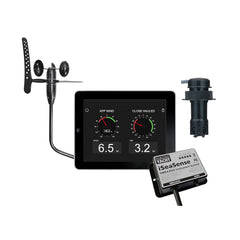
ᅠ ᅠ ᅠ ᅠ ᅠ ᅠ ᅠ ᅠ ᅠ ᅠ ᅠ ᅠ ᅠ ᅠ ᅠ ᅠ ᅠ ᅠ ᅠ ᅠ ᅠ ᅠ ᅠ ᅠ ᅠ ᅠ ᅠ ᅠ ᅠ ᅠ ᅠ ᅠ ᅠ ᅠ ᅠ ᅠ
Types of Depth Finders : There are various types of depth finders available, including basic depth sounders, fishfinders, and advanced combination units. Basic depth sounders provide depth readings only, while fishfinders offer additional features like fish detection. Combination units integrate GPS, chart plotting, and other advanced functions. Consider your boating activities and desired features when choosing the type of depth finder that suits you best.
Key Features to Consider: When selecting a depth finder, consider key features such as frequency, power, display type, transducer type, and additional functions. Higher frequencies provide better detail in shallow water, while lower frequencies penetrate deeper water. Power affects the device's ability to provide accurate readings at higher speeds or in rough conditions. Display type and size should be chosen for readability in various lighting conditions. Transducer type depends on your boat's hull and mounting preferences.
Additional functions like GPS, chart plotting, and networking capabilities can enhance your boating experience.
Installation and Maintenance : Proper installation is crucial for the optimal performance of your depth finder. Follow the manufacturer's guidelines and ensure the transducer is mounted correctly for accurate readings. Regular maintenance, including cleaning the transducer and checking connections, helps prolong the device's lifespan and reliability.
Choosing the Right Depth Finder: When choosing a Depth Finder for Boat, assess your boating needs, budget, and desired features. Consider factors like the type of water you navigate, the depth range you require, and the level of detail you need from the device. Research different brands and models, read user reviews, and consult with experts if needed to make an informed decision.
Click here for more information:
Ais
Xantrex Inverter
0 notes
Text
Park report: Week 16!
This week's park report is a little delayed--I didn't take the pictures until Monday, because of Easter festivities, and then I didn't get around to posting them, because of union meetings. But here we are, and there is some bonus content from today, featuring Willow: Live at the Quarry.

The big development at the park is that the purple trees are in bloom! I like the purple trees. They're so very purple. There are a lot of them in this area; you can be driving along the highway and occasionally among the roadside foliage there will be purple ones.

Here we are in the usual spot by the fishing pier, looking back toward the parking lot. Here you can see that purple-tree time also features white trees, which are nice too!

Now we are on the ledge down by the tunnel. This would be a boring picture today--no purple trees--but there are two people lying on the fishing pier trying to look under it. I did not ask why; perhaps they are looking for the Very Big Fish that lives in the canal.

Now we are walking up the big hill to the top of the tunnel. (This is the cardio portion of my exercise program, which is called "Walk the dog at the park more days than not." It's a good program!) Waiting for us at the top of the hill is a particularly good purple tree, which is why I took the picture.

Here we are at the top looking down; you can see that the daffodils are still hanging on up top, and there is a pink tree, as well!

Now it's today, and we are at the quarry! This is the same place that I saw the fish getting stocked--did I ever post those pics? Anyway, it's in the next town over, about 15 minutes away. There isn't a whole lot to do there except fishing and kayaking, but it's a great location for both!

If you row across, there is a rocky little peninsula, accessible only by boat. I brought Willow up on shore to have a look around.

Over there in the distance--before the building--is the parking lot; it isn't a very big body of water, but as you can sort-of see here, the water is pretty clear, and there are some dramatic depth changes, which makes for an interesting view as you float around. A guy who was at the fish-stocking said he'd been out with a depth finder once, and the deepest point is 39 feet. (2About 12 or 13 meters.)

Here's the other side of the little peninsula. Apart from the one of my feet, I didn't take any other pictures while afloat, because I had two fishing rods and a boat to handle, and it was Kind Of A Lot. But there were tons of fish swimming around, and I also saw 3 turtles and an Interesting Bird. The quarry is definitely on my list of approved boating locations!
9 notes
·
View notes
Text
Willy Wonka & the Chocolate Factory 1971
A classic I haven't seen in a long while, or possibly have never seen and only know through pop culture. A precursor of bad movies to come. Also it's a musical I forgot about that part.
They do the worldwide search for the golden tickets so well, apparently it wasn't much in the original book but they made it much longer in the movie and basically every skit landed. And our 5 lucky(?) ticket finders are really solid characters too, a bit one note but it works, this is a children's movie you don't really need depth for 4/8 side characters.
On the practical Effects in this movie, I don't think anyone's ever complained about them, The beginning area with the candy plants and chocolate river, really good, it's still visibly in a factory but you don't really notice that part because, candy plants and a chocolate river. The boat ride, looked really good, looked really evil? why was that scene so evil?
Like, a lot of this movie was weirdly evil, weird weird energies from Wonka and the oompa loompas/
Final Review: Really good movie though it's a classic, most people have probably seen parts of it or know of it, impossible to *not* know of it practically. Still makes it worth watching.
3 notes
·
View notes
Text
What is a deep cycle battery plus answers to your boat battery questions
As long as it looks like it’s doing its job, you probably don’t care much about your boat battery. In fact, many boat owners just use the original batteries that came along with their boat.
But what if your battery needs to be replaced? Or, what if you were buying your first boat? Do You Need Deep Cycle Marine Batteries? (yes!) Or would a starter battery do the trick? (Too!) Time to get to the boat batteries…and we’re here to help.
As technology advances, more and better batteries become available. But like a 10-page menu, more options make things more confusing. Might be more difficult to choose!
Marine batteries come in a variety of chemistry, sizes and uses. Before making a decision, it’s better to know what is a deep cycle marine battery, how does it works, and which is best.
First of all, we provide a short, less technical explanation of the most common terms on the boat battery:
Boat Battery Terms
Think of this basic term as “appetizer”. Familiarity with the battery vocabulary will help you to figure out the confusing specifications and jargon you may come across while shopping.
Amp Hour (AH)
This refers to the amount of energy your boat’s batteries can store. The larger the AH number, the larger the capacity.
Cycle
One cycle is a full discharge and a full charge. Deep cycle batteries usually have a cycle life or cycle rating. This rating indicates the number of cycles you can discharge and recharge the battery before it reaches 80% of its original capacity. At that point, most batteries will need to be replaced.
C rate (or Capacity Hour Rate)
It is actually a measurement of rate at which the battery be charged or discharged. You can also say it is the ratio between current draw, battery capacity and time. Most deep cycle marine batteries follow a standard 20 hour rate. The number “20” means discharge within 20 hours. For example, a battery with a capacity of 100AH and a rating of C20 can deliver 5 amps for 20 hours before being discharged.
Depth of Discharge (DOD)
This is the amount of your battery’s total capacity that you drain before recharging. For example, if your battery has reached 60% DOD, it means that you have 40% capacity left. A battery with a capacity of 100AH would have 60% DOD if you drained it to 40AH.
This is the total capacity of the battery that drain before recharging. For example, if your battery has reached 60% DOD, it means you have 40% capacity left only. If you drain a 100AH battery down to 40AH, it stands for 60% DOD.
Internal resistance
The term refers to the ability of a battery to resist energy as it is charged and discharged. The lower the internal resistance, the better. Batteries with higher internal resistance don’t charge as efficiently and can get hotter while charging because the energy lost is converted to heat.
State of Charge (SOC)
This is how much capacity your battery could be charged in. For example, a fully charged battery has a state of charge (SOC) of 100%.
What is a Deep Cycle Marine Battery?
Now for the main course: What is a deep cycle marine battery?This type of battery support you to power the trolling motor, radio, GPS, fish finder, and other gadgets on your boat (as well as RV parts, but that’s another topic). It is different from a starter battery or cranking battery, which we will discuss more below.
Deep cycle marine batteries can withstand multiple charges and discharges. That’s why (in most battery types) it has thick and heavy plates. It can survive rigorous charging and hundreds of cycles.
Like the tortoise in the old fable “The Tortoise and the Hare,” you might think of a deep cycle battery as a “slow and steady” power source. Their instantaneous power is limited. That’s why you can’t use them to start your motor. For this, you’ll need a starter/starter battery, which we discuss below.
5 notes
·
View notes
Text
Fishing is a calming and fun activity that allows you to spend time in nature. Whether you are an experienced fisherman or a novice, you will always look forward to your fishing trip. You must be well-equipped with the right fishing gear and equipment to reduce inconvenience and fatigue. When it comes to the most critical fishing equipment, a motorized fishing reel is at the top of the list. It has the capacity to transform an otherwise mundane fishing trip into something very enjoyable. However, when it comes to choosing the appropriate electric fishing reels, it's easy to become overwhelmed by the sheer number of options. To save you time and money, we've compiled a comprehensive electric fishing reels buyer's guide for you! Power Up Your Fishing Game: Why Electric Fishing Reels Are a Must-Have! Electric fishing reels are essential to the sport of fishing since they offer a number of benefits that are not available with manual fishing reels. The following are some of the reasons why: Less Physical Strain: Because electric fishing reels utilize an electric motor to retrieve the fishing line, you don't need to exert as much physical power to reel in your catch. This is because the electric engine does the work for you. When fishing for larger or tougher fish that are capable of putting up a fight, this comes in very handy. The electric motor inside of these reels allows the fishing line to be retrieved much more rapidly than it could be done with a manual reel. This can be useful when you must bring in your catch swiftly or when fishing in waters with a greater depth. Consistent Tension: Electric reels have an automated drag mechanism that keeps the fishing line under constant tension. This feature helps to reduce the risk of line breakage and improves the angler's ability to bring fish to the boat. Electric fishing reels can make fishing more efficient because they enable you to quickly retrieve and reset your line. This allows you to spend more time fishing and less time reeling in your catch, which results in increased efficiency. Accessibility: Electric fishing reels can make fishing more accessible and pleasurable for anglers with physical restrictions or impairments. All things considered, electronic fishing reels may be a helpful tool for fishermen of all skill levels, making the sport more productive and fun. Top Electric Fishing Reels DAIWA TANACOM 750 Electric Fishing Reels Daiwa is a well-known reel manufacturer, and the TANACOM 1000 electric reel is the best electric fishing reel. With a gear ratio of 2.3:1, this reel generates significant torque and has a maximum drag of 44 lbs. Everyone yearns for deep sea fishing, such as gigantic cock fish in the 20 kg class or meter class Greens, which reside deep beneath the luxury fish Kinky global target number. For a dream, high-power, high-value electric become solid allies. Maximum drag force of 20 kg-JAFS standard lifting force of 27 kg and aluminum round knob takes the running of big migratory fish to have sufficient power and smooth drag, to support the strong pick-up also fitted as standard. Features The line counter indicates the depth of your bait. Includes an automatic stop at certain depths and jigging capabilities to assist you in attracting that monster fish. It has a bigger line guide that allows you to pass through huge knots and swivels, which is beneficial for fishing big game, kite fishing, or drone fishing. It features a line counter that may be used in conjunction with fish finders to determine the depth at which you are fishing. Metal Spinning Reel by BERRYPRO SOLO BERRYPRO SOLO series fishing reels include a high-strength aluminum frame that significantly increases durability. They are exceptionally durable reels designed to compete for large fish in both freshwater and saltwater fishing. Washers made of carbon fiber guarantee enough drag force and steady casting. When fishing, the direct drive screw-in handle provides significantly more stability.
Features This electric fishing rod includes a CNC-machined high-strength aluminum frame structure that significantly increases durability. The BERRYPRO SOLO spinning reel's amazing smoothness results from the 7+1 double-shielded extremely smooth stainless steel ball bearings and precision computer-balanced gears. CNC aluminum spool featuring a chamfer on the spool lip to prevent line friction. Infinite rotation is Anti-reverse to prevent the rotor from rotating during casting. Electric Fishing Reels like BERRYPRO SOLO have three superior carbon fiber drag washers that provide ample drag force and reliable throwing. Completely waterproof construction to withstand liquid corrosion. It is substantially lighter than standard metal reels due to the distinctive light design of the line cup holder. When fishing, the direct drive screw-in handle provides significantly more stability. Carbon X Piscifun Spinning Reels The Carbon X Piscifun is precisely made with an all-carbon fiber body, rotor, and side plate, making it one of the lightest fishing reels. It significantly minimizes wrist fatigue after a long day of pursuing prize fish. The Carbon X has fantastic features, including a strengthened anti-corrosion stainless steel main shaft and Zinc Alloy drive gear, a screw-in aluminum handle with direct drive, a hollow nest-shaped spool, a smooth positive click drags, and a high-density EVA knob. Features The Carbon X spinning electric reel boasts a quick 6.2:1 gear ratio and a buttery smooth 5.1:1 in the 1000 model. These two gear ratios are ideal for battling the strongest, fastest runs of the largest fish, while the intermediate pace is ideal for finessing your next prize. Carbon X's amazing smoothness will blow you away. The 10+1 shielded stainless steel ball bearings are crucial for enhanced smooth operation, retrieval performance, and corrosion resistance. Three quality large carbon washers provide the greatest-in-class drag power of up to 33 lbs, while the sealed rubber ring protects your drag from water and dust. These drag elements provide the best experience, whether chasing a competition kicker or enjoying a day on the lake with your kids. Sougayilang Electric Fishing Reels- Ultralight in Vibrant Colors Over the years, Sougayilang has discreetly supplied fishing aficionados worldwide with his sophisticated fishing gear, amassing a significant following with the best value. The Sougayilang electric fishing rod includes a graphite frame that is both lightweight and extremely robust. With the hollow frame design, computer-balanced system, and high performance and lightweight for extended fishing, you no longer need to use a backing line while spooling the braid fishing line to avoid slippage. Features The Sougayilang spinning reels deliver maximum performance and durability to all fishermen seeking victory. The primary driving gear is constructed of a robust zinc alloy and is paired with a solid brass pinion gear. Both provide the stiffness and smoothness required to construct reels capable of withstanding harsh circumstances. Its ultra-smooth performance results from 12 corrosion-resistant smooth ball bearings and one immediate-stop one-way anti-reverse bearing. Each fishing reel includes an extraordinarily smooth, endlessly adjustable drag mechanism that yields over 39 lbs. The reel's sensitivity is increased due to the improved sounding coil. Sougayilang equipped the handle with highly comfortable, slip-resistant Super Polymer handle knobs to provide secure and easy control of your reel. This motorized fishing reel is an excellent choice for freshwater fishing. Ideal for gamefish, including freshwater species such as bass, walleye, and trout, as well as popular inshore species such as redfish, speckled trout, and flounder. Conclusion Electric fishing reels are usually preferable to conventional reels. The best thing is that they cost the same as a high-quality traditional reel but include various sophisticated capabilities that make fishing more enjoyable and simpler.
Although electric fishing reels are not required, with sophisticated gear, you'll be able to capture more fish with less effort. Additionally, these reels are reversible. You may use them as standard reels if they run out of power. They are highly resilient and require little maintenance. Thus, investing in a high-quality electric fishing reel is unquestionably the wisest course of action. FAQs How do electric fishing reels work? It is very easy to fish using electric fishing reels. Attaching a long ladder to the sink with a pair of squid and fish feed is a good choice for catching fish using electric deep-sea fishing reels. A button on the reel box is designed to use the reel and track depth in water. What is the best electric fishing reel? All the above-mentioned electric fishing reels are equipped with the latest features and are considered electric deep-sea fishing reels. You can choose any of them as the best electric fishing reel.
1 note
·
View note
Text
“Smooth Sailing: How to Choose and Book the Perfect Boat for Your Next Adventure”
From luxurious catamarans to speedy jet boats, renting a boat offers a unique experience on the water. But how do you know what to rent and where? Here’s your complete guide to choosing the perfect boat for your needs.
1. Decide the Purpose of Your Trip
Is it for fishing, cruising, a romantic dinner, or water sports? Your purpose determines the type of boat.
Pro Tip: For party cruises, book a catamaran with a deck sound system via BookBoatsNow.com
2. Types of Boats to Consider
Pontoon Boats: Great for families and relaxed cruising
Fishing Boats: Equipped with rod holders and depth finders
Yachts: For luxury events or overnight stays
Jet Skis & Speed Boats: Ideal for thrill-seekers
3. Check the Credentials
Only book from licensed operators. Ensure life jackets, first aid kits, and safety briefings are provided.
4. Set Your Budget Smartly
Prices vary by boat type, hours, location, and amenities. Early bookings and off-season dates can save big.
5. Use Trusted Platforms
Book through reputable platforms like Book Boats Now for verified listings, transparent pricing, and insurance options.
6. Don’t Forget the Extras
Think about catering, music system, photography, or water toys—many rentals offer them as add-ons.
Conclusion
Boat rentals offer incredible flexibility and fun—but only if chosen wisely. So plan your dream day on the water with confidence and style. Ready to sail? Book your next trip now
0 notes
Text
Gulfstream Boat Club is the premium, family-friendly and affordable alternative to boat ownership. Our flexible membership packages are built to suit any lifestyle. Every member has the ability to reserve boats at any of our locations any day of the week, with no blackout periods or fine print. Our premium fleet is kept in peak performance, and equipped with fantastic bluetooth sound systems, touchscreen GPS and depth finders, comfortable seating, and so much more.
Gulf Stream Boat Club
5216 W Tyson Ave, Tampa, FL 33611
(888) 702-2256
https://www.gulfstreamboatclub.com/
1 note
·
View note
Text
Gulfstream Boat Club is the premium, family-friendly and affordable alternative to boat ownership. Our flexible membership packages are built to suit any lifestyle. Every member has the ability to reserve boats at any of our locations any day of the week, with no blackout periods or fine print. Our premium fleet is kept in peak performance, and equipped with fantastic bluetooth sound systems, touchscreen GPS and depth finders, comfortable seating, and so much more.
Gulf Stream Boat Club
240-B Madonna Blvd, St. Petersburg, FL 33715
(888) 702-2256
https://www.gulfstreamboatclub.com/
1 note
·
View note
Text
What Are Waterproof Switch Panels and Why Are They Essential for Marine and Outdoor Use?
In environments where moisture, salt, and weather elements are constant challenges—like on boats or off-grid outdoor setups—traditional electrical components simply don’t cut it. Waterproof switch panels are specifically engineered to withstand harsh conditions while providing reliable control over various electrical systems.
Understanding Waterproof Switch Panels
Waterproof switch panels are control units designed to manage multiple electrical circuits in environments exposed to water, humidity, or extreme weather. Unlike standard switch panels, they come sealed with durable, weather-resistant materials like marine-grade plastic or stainless steel and include rubber gaskets, waterproof seals, and IP-rated protection.
You’ll often find these panels on boats, RVs, campervans, off-road vehicles, and even solar-powered outdoor installations. They make it possible to control lights, pumps, radios, and more—all from one compact, protected interface.
Why Standard Switches Fail Outdoors
Let’s say you're navigating a small fishing boat on a lake. A light drizzle starts—no big deal, right? But if your switch panel isn’t waterproof, even minimal moisture can cause corrosion, short circuits, or complete electrical failure.
Traditional switches are vulnerable to:
Water intrusion
UV degradation
Saltwater corrosion
Mechanical wear due to outdoor use
These failures aren’t just inconvenient; they can be hazardous. Imagine a bilge pump or navigation light going out mid-voyage—without a functioning switch panel, your safety is at risk.
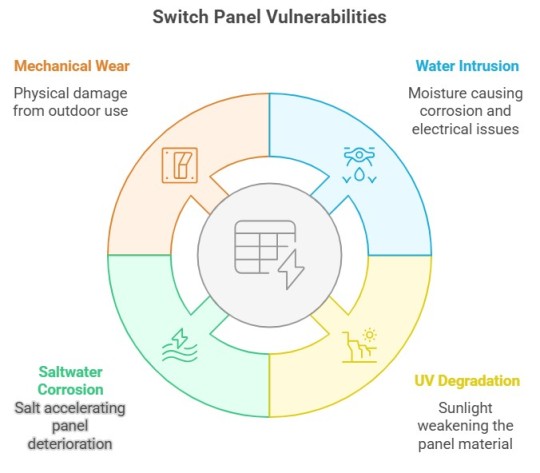
Key Features of Waterproof Switch Panels
IP Ratings and What They Mean
One of the most crucial aspects of any waterproof panel is its Ingress Protection (IP) rating. For example, an IP67-rated panel is dust-tight and can handle immersion in up to 1 meter of water for 30 minutes. That’s exactly what you want in marine or exposed environments.
Durability That Goes Beyond the Surface
High-quality waterproof panels are typically UV-resistant and impact-resistant. Whether mounted on the dashboard of a boat or the side panel of a 4WD vehicle, they’re designed to endure vibrations, exposure to sunlight, and sudden weather changes without cracking or malfunctioning.
Touch Switch Panels: The Modern Alternative
Some modern designs incorporate touch switch panels, which offer a sleeker, button-free interface that’s easier to clean and often longer-lasting. These are great for users who prefer a more high-tech and minimal look without compromising durability.

Real-World Applications
Marine Use: Designed for the Unexpected
Boats often have a host of electrical systems—navigation lights, depth finders, radios, water pumps, etc.—that all need individual control. A marine-rated switch panel consolidates this functionality in one spot, saving space and ensuring you can manage everything even in choppy conditions. Many switch panels used in boats now come with LED indicators, circuit breakers, and even USB charging ports.
Example: A Sydney-based charter boat operator recently upgraded to a marine-grade waterproof switch panel with illuminated touch switches. The captain reported fewer electrical issues and easier night-time operation, thanks to the backlit labels and waterproof build.
Off-Grid and Outdoor Installations
Whether it’s a solar-powered shed, a caravan, or a mobile coffee truck, outdoor setups need switches that can handle more than just occasional rain. Waterproof panels ensure you won’t lose power to lighting, fans, or charging systems due to weather exposure.
Example: A customer installing a solar panel system in a remote cabin in the Blue Mountains found that a waterproof panel allowed them to control everything from water pumps to perimeter lights—all without worry about moisture-related damage.
Choosing the Right Waterproof Switch Panel
Number of Circuits
How many systems are you controlling? Some panels offer as few as 2 circuits, while more advanced ones provide 6 or more. Think about current and future needs.
Voltage and Amperage Rating
Make sure your panel matches your electrical system’s specs—12V, 24V, etc.—and can handle the current load without overheating or failing.
Design and Mounting
Look for backlit labels, custom switch icons, and sealed mounting systems that fit your application. Flush-mount designs are great for tight spaces like boat dashboards or vehicle interiors.
Internal vs External Use
Even if you’re mounting inside a cabin or under a canopy, don’t assume a standard panel will suffice. Condensation alone can ruin exposed circuitry, making waterproofing essential.

Do You Actually Need One?
If you’re asking yourself whether a waterproof switch panel is worth the investment, the answer depends on your use case. If your setup lives entirely indoors in a controlled environment, then maybe not. But for anyone working or playing in the elements—boaters, campers, off-roaders—it’s not just a luxury; it’s a necessity.
Water, salt, and dust don’t take days off. Your electrical controls shouldn’t either.
You can’t control the weather, but you can control how well your gear holds up to it. Investing in a waterproof switch panel means investing in reliability, safety, and long-term performance—especially in unpredictable outdoor environments. Whether you're navigating open water or wiring up an off-grid retreat, this small piece of hardware could make the biggest difference.
0 notes
Text
Boat Inspections
Owning a boat is one of life’s greatest pleasures—whether it’s for weekend fishing trips, leisurely sailing, or thrilling offshore adventures. But behind the beauty and enjoyment of boating lies a serious responsibility: ensuring that your vessel is safe, functional, and compliant with maritime regulations. That’s where High Tide Boating comes in. With our expert boat inspection services, we give you peace of mind so you can focus on what matters most—enjoying the open water.
Why Boat Inspections Are Essential
A boat, like any vehicle, requires regular maintenance and checkups to ensure it operates safely. Unlike cars, however, boats are exposed to corrosive saltwater, sun, and shifting marine conditions that accelerate wear and tear. Even a minor issue can lead to major problems if overlooked. A comprehensive inspection can prevent costly repairs, ensure safety, and increase the longevity of your vessel.
Whether you’re preparing for a long voyage, selling or purchasing a boat, or simply keeping up with annual maintenance, a professional inspection is a crucial step in responsible boat ownership.
What Sets High Tide Boating Apart
At High Tide Boating, we’re more than just inspectors—we’re experienced mariners, certified technicians, and passionate boating enthusiasts. Our team brings decades of hands-on expertise and industry certification to every job. We understand the unique concerns of boat owners because we’re boaters ourselves.
We’ve built our reputation on trust, transparency, and thoroughness. Each inspection we perform is guided by the highest safety standards and customized to your specific vessel type and usage. We serve clients ranging from first-time buyers to seasoned captains, always with the same commitment to detail and service.
Our Inspection Services
We offer a range of boat inspection packages to suit your needs. Whether you're performing routine checks or need a full pre-purchase inspection, our team is equipped with the tools, knowledge, and training to assess all critical systems and components. Here’s what we typically cover:
1. Hull and Structural Integrity
We inspect the entire hull—above and below the waterline—for cracks, blisters, damage, or signs of previous repairs. We assess transoms, stringers, decks, and bulkheads for sound construction and water intrusion. Structural integrity is critical for safety, and we don’t cut corners.
2. Mechanical and Engine Systems
From inboard diesel engines to outboard motors, our technicians perform full mechanical evaluations. We check oil quality, compression, cooling systems, belts, hoses, and mounts. We also inspect steering and throttle controls for smooth, responsive operation.
3. Electrical Systems
We ensure that your electrical systems—batteries, chargers, inverters, lights, gauges, and wiring—are properly installed, corrosion-free, and functional. Poor electrical connections are a common cause of onboard issues, and we take special care in this area.
4. Fuel System
We inspect tanks, fuel lines, filters, and fittings for leaks, corrosion, and wear. We also check for proper ventilation and ensure compliance with U.S. Coast Guard and ABYC safety standards.
5. Safety Equipment
Our inspections include a thorough review of all safety gear: life jackets, fire extinguishers, flares, horns, bilge pumps, and emergency signaling devices. If something is outdated or missing, we’ll let you know and offer guidance on replacements.
6. Plumbing and Water Systems
For boats with freshwater systems, heads, or galley equipment, we check for leaks, pump operation, and general condition of hoses and fittings. Sanitation systems are also reviewed for proper installation and functionality.
7. Navigation and Electronics
We test the operation of onboard electronics such as GPS, radar, VHF radios, depth finders, and chart plotters. Reliable navigation is key to safe boating, especially offshore or in poor visibility.
8. Deck and Hardware
Cleats, winches, rails, hatches, windlasses, and other deck hardware are checked for secure installation and smooth function. Non-slip surfaces, anchor lockers, and drains are also inspected.
Types of Inspections We Offer
Pre-Purchase Inspections – A full survey designed to evaluate the condition of a vessel before you buy. It’s your best insurance against costly surprises.
Annual Safety Inspections – Ideal for seasonal or annual checkups to ensure continued safe operation.
Insurance & Loan Inspections – Many insurers and lenders require a certified condition and value report, which we are fully qualified to provide.
Custom Inspections – If you have specific areas of concern or need a limited-scope evaluation, we can tailor an inspection to your requirements.
Inspection Reports You Can Trust
After every inspection, you’ll receive a detailed, easy-to-read report that outlines our findings. We include photographs, notes on the condition of each component, and recommendations for repair or maintenance. Our reports are accepted by insurance companies, lenders, and brokers alike, and can serve as a valuable asset during negotiations or resale.
Mobile Service: We Come to You
High Tide Boating offers mobile boat inspections throughout the region. Whether your boat is docked at a marina, moored offshore, or on a trailer at home, our team can come to your location. This makes the inspection process easy and convenient—no hauling or launching required.
Education for New Boat Owners
New to boating? We’re here to help. During and after your inspection, we’re happy to answer questions, explain what we find, and walk you through the essentials of boat maintenance. Our goal is not only to assess your boat—but to empower you as an informed and confident owner.
Why Customers Choose High Tide Boating
Certified & Insured: Our technicians are certified by ABYC, NMEA, and other respected industry bodies. We carry full professional liability insurance.
Transparent Pricing: Our pricing is competitive and clear—no hidden fees or upsells.
Timely Reports: We deliver inspection reports quickly, often within 24-48 hours.
Customer-First Approach: We prioritize your needs, timeline, and concerns at every step of the process.
0 notes
Text
Technologies Changing the Fishing Industry

Fishing, both as a hobby and a profession, traditionally relied on intuition and understanding nature. However, recent technological advances have transformed the way fishers interact with aquatic environments, making fishing practices more sustainable, data-driven, accessible, and efficient. Understanding some of the technologies used in modern fishing can improve your fishing experience.
GPS and mapping technologies have been instrumental in helping anglers and fishers navigate and track locations on the high seas. Some modern boats have integrated chartplotters that display tidal charts, depth contours, and topographical maps of lakes. This means that anglers are better equipped to log the catches they make in specific areas, mark hotspots, and share waypoints with other anglers. In addition to improving the efficiency of fishing efforts, GPS technologies help anglers avoid certain parts of the high seas, ensuring their safety.
Similarly, the adoption of fish finders and sonar technologies has changed how fishing operations are conducted. Fish finders usually send sound waves through the water and use the returning echoes to detect a cluster of fish. Some fish-finding technologies, such as Lowrance, Humminbird, and Garmin, have 360-degree sonar, down-imaging, and side-imaging capabilities that allow anglers to remotely see what's happening beneath the sea. The effectiveness of fish finders has made them almost indispensable in most large-scale fishing efforts. They convert hours of trial and error into minutes of productivity by helping anglers narrow down fishing spots.
Also, the use of cloud platforms and mobile technologies like ANGLR, Navionics, and Fishbrain makes it easiest for fishers to log their catches, connect with other fishing communities, and study weather patterns. These cloud platforms often utilize crowdsourced data, allowing anglers to contribute to a database of fishing intelligence. With this, it is easier to decentralize access to fishing knowledge while fostering a healthy sense of community among anglers.
Technology is helping both conservationists and everyday anglers be more mindful of their catch. Tools like electronic catch recorders, digital scales, and tagging devices are enabling researchers to track fish populations with greater accuracy. Many commercial and recreational boats now use electronic logbooks that transmit real-time data on what's being caught, which helps fisheries regulators manage stocks more effectively. Catch-and-release monitors are also gaining popularity, allowing anglers to check if a fish is healthy enough to be released back into the water, which supports better outcomes for aquatic ecosystems.
Another exciting advancement is the use of drones in fishing. Drones are particularly useful in surfcasting and offshore fishing, allowing anglers to scout for schools of baitfish or favorable water conditions from above. They can also be used to drop bait in hard-to-reach spots, extending an angler's reach well beyond the shore. Aerial imagery from drones helps assess environmental features, such as water clarity, vegetation, and access points, all of which can be difficult to evaluate from ground level.
The evolution of smart fishing gear is also changing the game. Some modern rods and reels are now equipped with sensors that track everything from casting distance to retrieve speed, syncing with smartphone apps to give users real-time feedback and personalized tips. Wearables designed for anglers, such as smartwatches or activity trackers, can monitor environmental conditions like wind speed, barometric pressure, and water temperature. These insights help anglers make better decisions and recognize patterns over time, making their fishing trips not just more successful but also more informed and enjoyable.
1 note
·
View note
Text
Local’s Guide to Lake Norman Boating: Best Coves, Marinas, and Water Activities
Lake Norman has become the go-to summer retreat for boating enthusiasts from Charlotte and beyond. But even seasoned lake-goers are surprised by how many hidden treasures still await discovery. Here’s a quick guide to some lesser-known spots and helpful tips to make the most of your time on North Carolina’s largest man-made lake. Top Marinas for a Smooth Start Lake Norman Marina (Sherrills Ford): Family-owned since 1973, this marina offers everything from pontoons to premium boats, with staff ready to help boaters of all experience levels. Carolina Boat Rentals: Ideal for lakefront vacationers, they deliver boats right to your location and offer scenic tours showcasing lakefront landmarks. Tip: If you're looking for a permanent slip, plan early—covered slips often have long waiting lists. Coves Worth Exploring Stumpy Creek Cove: Spacious yet calm, perfect for swimming with its sandy bottom and wind protection. Davidson Creek: A quiet, family-friendly spot with a network of smaller coves and peaceful waters. Ramsey Creek: A lively social hub on weekends, great for group gatherings and near Ramsey Creek Park. Mountain Creek: Cooler, shaded waters and deep channels make it perfect for hot summer days and consistent navigation. Fun on the Water Fishing: Great catches near the Highway 150 bridge, especially in the calm early mornings. Paddleboarding/Kayaking: Best around Lake Norman State Park, where you’ll enjoy wildlife and tranquility. Water Sports: Smooth conditions in the early hours make wakeboarding and skiing ideal. Sunset Cruises: The western shoreline offers some of the lake’s best views—perfect before dinner at places like North Har bor Club. Boating Tips for a Safe Ride Use depth finders to avoid submerged structures. Keep an eye on fast-changing weather, especially afternoon storms. Nigh time boating? Use proper lights and navigate slowly. Avoid peak crowds by hitting the water early or later in the day. Best Times to Visit Spring (Late April–May): Clear waters, mild temps, and fewer boats. Fall (September–October): Warm waters and beautiful early fall colors. Winter: Quiet, peaceful boating days for those willing to bundle up. For boat rentals or lakeside property insights, contact Frank at 704-201-5262 for personalized recommendations
0 notes
Text
Boating Must Haves That Improve Performance and Enjoyment
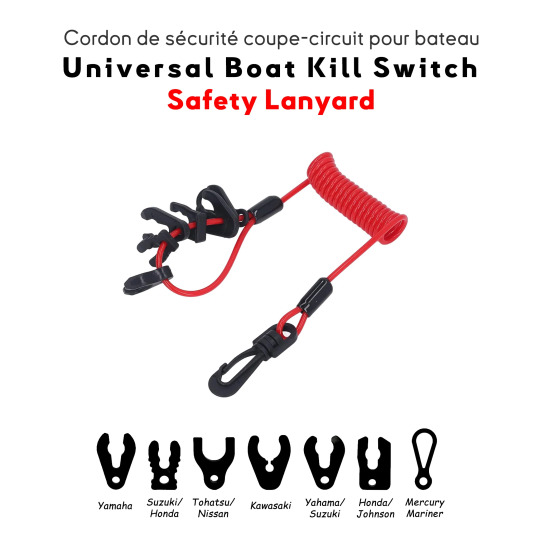
Boating is more than just a pastime—it's a lifestyle. Whether you're cruising the coastline, fishing with friends, or enjoying water sports with family, the right gear can make all the difference. For those who love the open water, investing in reliable, functional accessories enhances not just comfort but also safety and performance. Here’s a roundup of must have accessories for boat owners, designed to boost your time on the water.
1. Reliable GPS and Navigation Systems
Nothing is more essential than knowing where you are and where you're headed—especially out on open waters. A dependable GPS or chartplotter is crucial for both seasoned captains and new boaters. Many modern systems come equipped with touchscreen controls, real-time weather updates, and compatibility with smartphones, allowing for smoother, safer navigation.
2. Waterproof Storage and Dry Bags
Water and electronics don’t mix. That's why waterproof storage solutions, like dry bags and sealed containers, are vital for keeping valuables—phones, cameras, keys—safe and dry. A dry bag with roll-top closure is simple, affordable, and incredibly effective. Some even float, making them easy to retrieve if they go overboard.
3. Marine Audio Systems
The perfect soundtrack can elevate your boating experience from great to unforgettable. Marine-grade audio systems are built to withstand saltwater, humidity, and extreme temperatures. Consider speakers with Bluetooth capability, waterproof casings, and powerful bass for an immersive sound experience while you cruise.
4. Bimini Tops and Boat Covers
Protecting your boat from the elements is essential for long-term maintenance. A Bimini top offers much-needed shade on sunny days and shields passengers from UV rays. High-quality boat covers protect your vessel when it's docked or stored, guarding against sun damage, dirt, and rain. Choose materials that are breathable and mold-resistant to prevent mildew buildup.
5. LED Lighting for Ambience and Safety
Good lighting on a boat serves dual purposes—practicality and aesthetics. Interior and exterior LED lights enhance visibility at night, aid in docking, and add ambiance to evening parties or quiet cruises. They consume less power and are available in a variety of colors and styles. Many are also waterproof, making them ideal marine-grade boat accessories.
6. Multi-Tool Kits and Emergency Gear
Every boat should have a well-stocked toolkit and emergency supplies on board. A marine multi-tool equipped with a knife, pliers, screwdrivers, and cutters can handle unexpected repairs. Additionally, a first-aid kit, fire extinguisher, signaling devices, and life vests are mandatory safety essentials. Regularly check expiration dates and replace items as needed.
7. Boat Grills and Coolers
Dining on the water is one of boating’s greatest pleasures. Portable boat grills, especially those designed to clamp onto rails or sit securely on deck, let you cook up fresh meals with ease. Pair that with a quality marine cooler to keep drinks icy cold. Look for models with UV resistance, thick insulation, and slip-resistant feet to keep everything stable.
8. Anchor Systems
Having a reliable anchor is a game-changer for boaters who enjoy swimming, fishing, or just taking in the scenery. Choose an anchor that fits the size and weight of your boat and is suited for the water conditions you frequent—whether sandy, muddy, or rocky. A durable rope or chain setup and a retrieval system make anchoring smooth and stress-free.
9. Fish Finders and Rod Holders
For fishing enthusiasts, investing in high-quality fish finders and rod holders is non-negotiable. Fish finders use sonar to locate schools of fish, submerged structures, and changes in water depth. Rod holders help keep your lines secure and free up your hands, allowing for a more relaxing experience.
10. Docking and Mooring Equipment
Coming into dock doesn’t have to be stressful if you have the right gear. Fenders, dock lines, and cleats help protect your boat from damage when tying up. Quick-release hooks and spring-loaded mechanisms also make it easier to manage mooring without needing extra hands on deck.
11. Handy Boat Accessories for Day-to-Day Use
When it comes to convenience, a few clever tools can make life at sea far more enjoyable. Cup holders, rope organizers, telescoping boat hooks, and non-slip mats may seem minor, but they contribute to smoother sailing. These handy boat accessories keep everything organized and accessible, so you can focus more on fun and less on frustration.
Final Thoughts
Boating is an adventure—but with the right gear, it can be a safe, luxurious, and efficient one. From tech tools and safety gear to comfort enhancers and fishing upgrades, these accessories are investments that pay off in enjoyment and peace of mind. Whether you're a weekend warrior or a full-time sailor, don't leave the dock without these essentials.
And when you're ready to upgrade your setup, BayWatt has you covered. Our curated selection of high-performance marine accessories meets the demands of serious boaters, with quality and durability you can trust.
0 notes
Text
Power & Precision: Minn Kota 24V & Ulterra Trolling Motors | By DJ’s Marine
When it comes to maximizing your time on the water, choosing the right trolling motor can make all the difference. For anglers and boating enthusiasts looking for a balance of power, convenience, and cutting-edge technology, the Minn Kota 24V trolling motors and the feature-rich Minn Kota Ulterra stand out as top choices. At DJ’s Marine, we proudly offer both options to suit a wide range of fishing needs—from relaxed lake cruising to high-performance angling.
Why Choose a 24V Trolling Motor?
Trolling motors are available in 12V, 24V, and 36V configurations, with the 24V system striking an ideal balance between power and efficiency. Perfect for medium to larger boats, a 24-volt Minn Kota trolling motor offers more thrust than a 12V motor, without the additional weight or complexity of a 36V system.
Key Benefits of Minn Kota 24V Motors:
Increased Thrust A 24V system typically delivers 70–80 lbs of thrust, providing enough power to handle strong currents and windy conditions on mid-sized boats.
Better Battery Life By splitting the load between two deep-cycle marine batteries, a 24V system offers longer run times than 12V motors.
Reliable and Efficient Minn Kota's 24V motors are engineered for quiet operation, precise speed control, and excellent durability—even in demanding conditions.
Ideal for Versatile Applications Whether you're fishing freshwater lakes or navigating through shallow waters, Minn Kota’s 24V motors offer smooth, controlled movement for better positioning and boat handling.
The Ulterra: Effortless Fishing with Auto Stow/Deploy
If you’re ready for full automation and top-tier features, the Minn Kota Ulterra is one of the most advanced trolling motors available. Known for its Auto Stow and Deploy feature, the Ulterra allows you to drop or raise the motor with just the press of a button—no manual lifting required.
Standout Features of the Minn Kota Ulterra:
Auto Stow & Deploy Control deployment from the wireless remote, foot pedal, or even through a connected Humminbird fish finder—perfect for solo anglers or those who want to stay seated and focused.
Power Trim Adjust the motor depth electronically to suit shallow or deep water, without getting up or reaching over the bow.
i-Pilot or i-Pilot Link GPS Systems Lock onto a fishing spot with Spot-Lock, use AutoPilot to maintain a heading, or record routes and retrace them. With i-Pilot Link, you can even integrate with your fish finder for a fully connected fishing experience.
Available in 24V & 36V Options Choose a 24V Ulterra if you have a medium-sized boat and want balanced performance, or go 36V for maximum thrust on larger vessels.
Universal Sonar 2 Compatibility Reduce cable clutter and protect your transducer with built-in sonar compatibility, streamlining your electronics setup.
Why Shop at DJ’s Marine?
At DJ’s Marine, we do not just sell trolling motors—we help you find the perfect setup for your boat and fishing style. Whether you are buying your first trolling motor or upgrading to the latest tech, we offer:
Expert Advice Our team understands the needs of serious anglers and casual boaters alike. We will help you pick the right voltage, shaft length, and feature set.
Installation Support We offer professional installation services to ensure your Ulterra or 24V motor performs at its best.
Top Brands, Competitive Pricing We carry a full line of Minn Kota products and accessories, all at competitive prices with manufacturer-backed warranties.
Final Thoughts
Whether you are after simplicity, power, or high-end automation, Minn Kota’s 24V trolling motors and the feature-rich Ulterra offer top-tier solutions to meet your needs. With options that cater to different boat sizes and angling styles, there is a perfect trolling motor waiting for you at DJ’s Marine.
Visit DJ’s Marine today to find the right motor for your next adventure - and experience smoother, smarter fishing every time you hit the water.
0 notes
Text



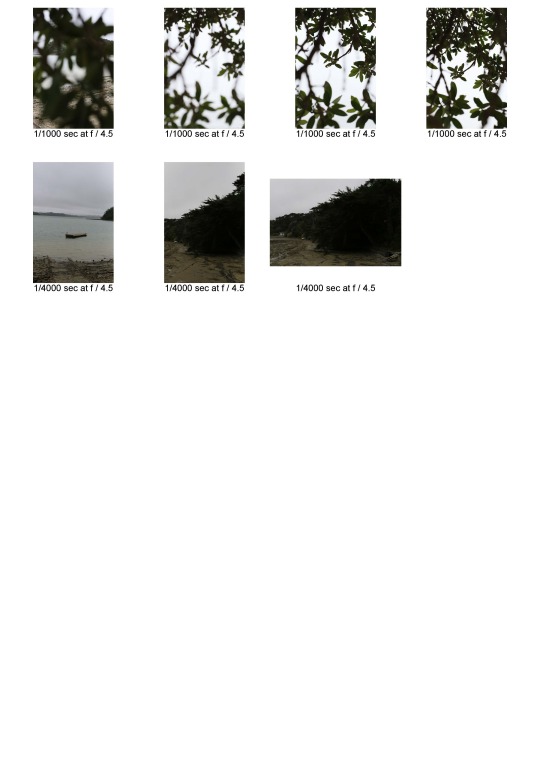

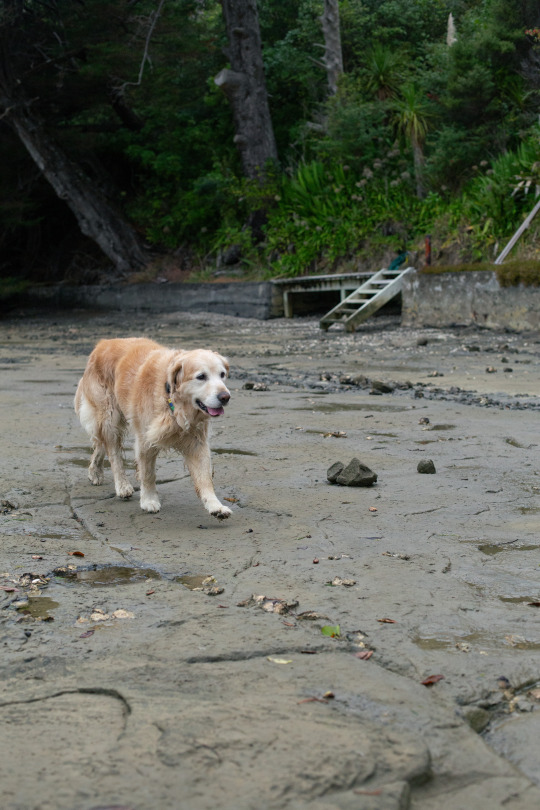


Day 4 I went up to my family bach for easter and took some photos of my favourite things down at the beach. It's a very special spot that my great granddad bought in the 1960s, and myelf, my sisters and cousins as well as my mum and her brothers have been lucky enough to grow up coming here most holidays. It was an overcast day, which was really good for getting softer light. A few photos in the middle there I was too busy looking through the view finder and forgot to check my light meter, and as a result are overexposed.



Day 5 there were lots of Piwakawaka out in the afternoon which I tried to capture. Turns out it is very hard to take photos of little birds, I would have benifited from a longer lense. The background was very detailed, which makes the piwakawaka get a bit lost. I could have solved this by decreasing the apeture to get a greater depth of field, but I was struggling to get them in focus.

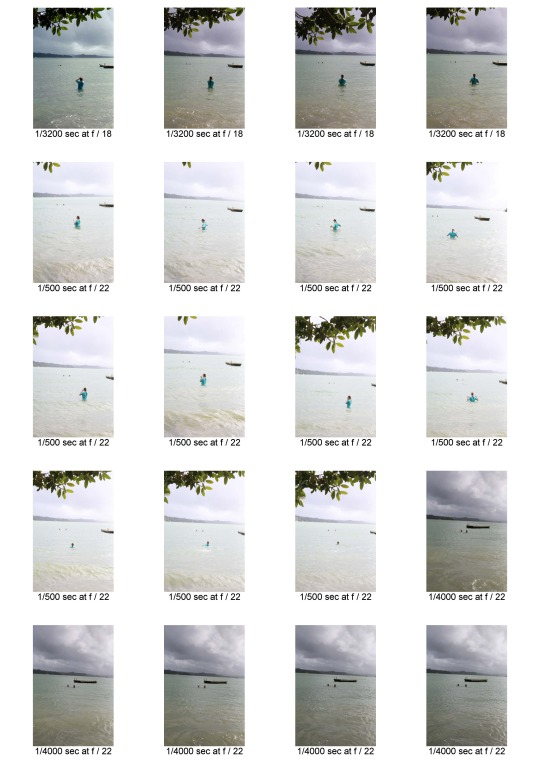

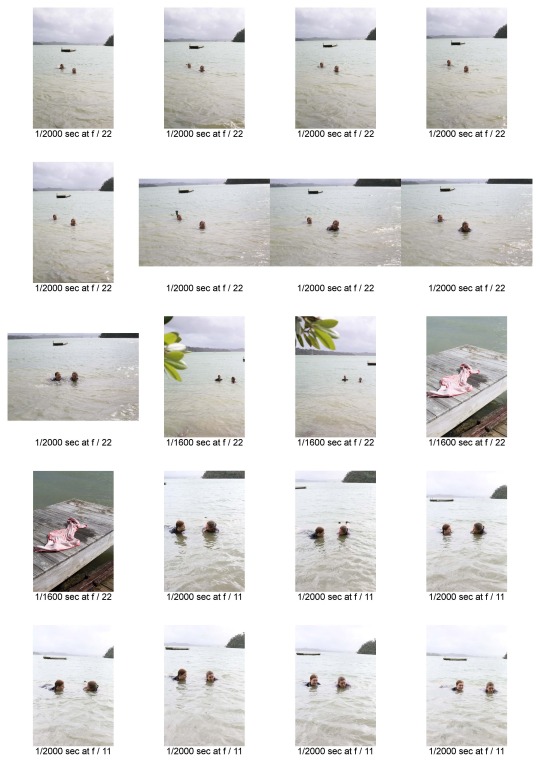

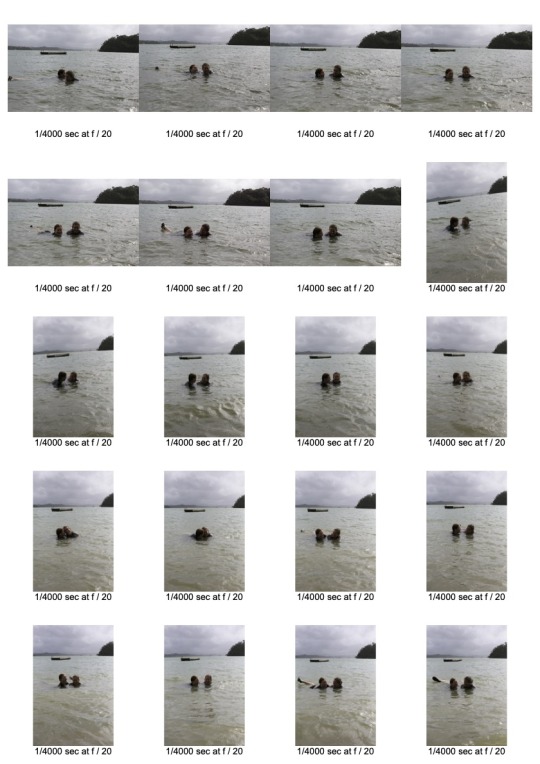

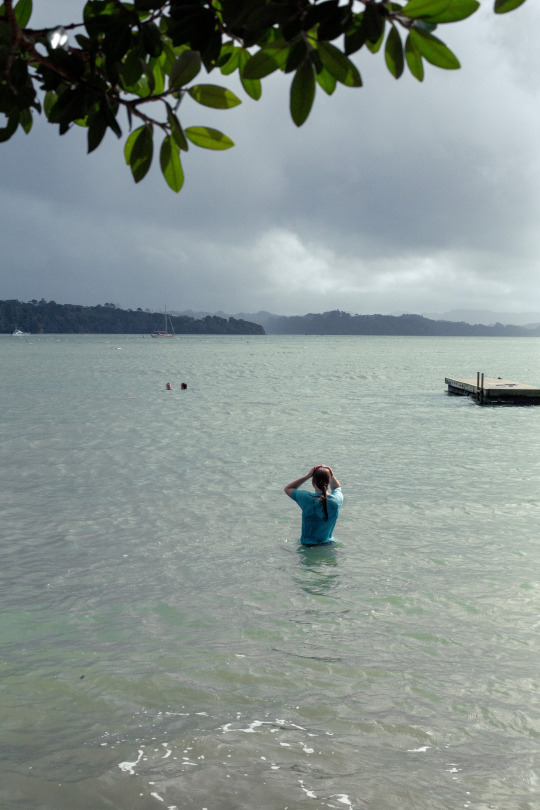
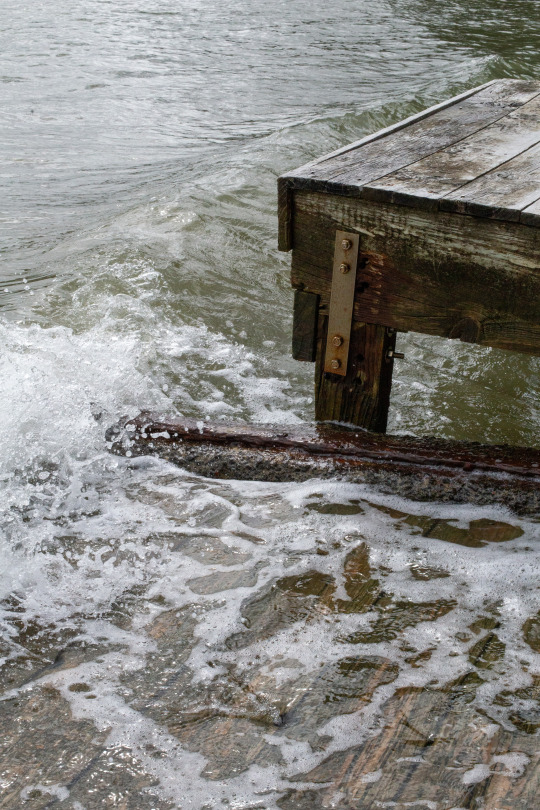

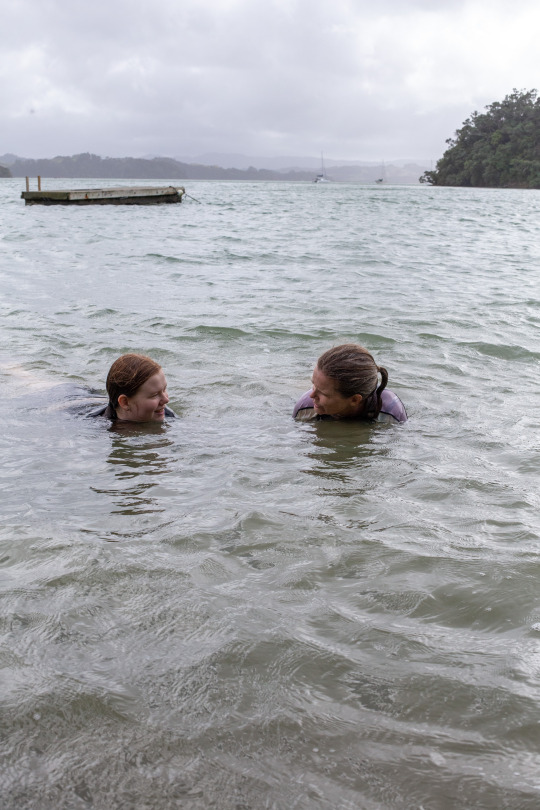

Day 6 I went swimming with my mum and sisters (it was, believe it or not, not that cold!), a classic activity for my family all year round. The struggle of this photoshoot was not freezing to death in my wet togs, and getting good photos of people while not interupting their swim too much. I took a photo of my wet towel and butt print on the boat ramp that I think is interesting; showing where someone clearly was, without them being there.
0 notes
Text
Top Boat & Marine Dealership in Fort McMurray, AB
When it comes to marine adventure in Fort McMurray, there’s one name locals trust above all others — Conlon Motorsports. Whether you're chasing sunsets on Gregoire Lake, gearing up for a weekend of fishing, or just enjoying life on the water, we’ve got everything you need to make every outing unforgettable.
At Conlon Motorsports, we’re proud to be Fort McMurray’s top boat and marine dealership, offering premium boats, motors, and watercraft for every kind of water enthusiast. From first-time boaters to seasoned pros, our team is here to help you make the most of Alberta’s stunning waterways.
A Wide Selection of Boats for Every Lifestyle
We carry a carefully selected inventory of top-quality marine brands, including fishing boats, pontoon boats, and high-performance outboards. Whether you’re planning a quiet day of trolling or a high-speed adventure with family and friends, Conlon Motorsports has the perfect match for your needs and budget.
Looking for power and precision? Ask us about our lineup of outboard motors — ideal for both recreational cruising and serious angling. Prefer comfort and space? Our pontoon boats are built for relaxation, socializing, and enjoying the water with ease.
Full-Service Marine Dealership
At Conlon Motorsports, we’re more than just sales — we’re your full-service marine destination. When you purchase a boat from us, you also gain access to our expert marine team for everything you need down the line.
Parts & Accessories: We stock a wide range of genuine marine parts & accessories to keep your boat customized and ready for action. From depth finders and rod holders to safety gear, lighting, and electronics, we help you equip your vessel exactly the way you want it.
Service & Repair: Need regular maintenance or troubleshooting help? Our certified marine technicians offer professional service & repair for all makes and models. We understand that time on the water is precious, so we work quickly and efficiently to keep your boat in top condition all season long.
Why Choose Conlon Motorsports?
We’re passionate about boating and the outdoors — just like you. That’s why we’ve built our dealership on three simple principles: honesty, expertise, and customer-first service. Our knowledgeable staff is always available to guide you through the buying process, assist with upgrades, and keep your investment running smoothly for years to come.
Whether you’re browsing our showroom, picking up parts, or scheduling a tune-up, you can count on personalized support and a commitment to quality every step of the way.
Visit Us Today
If you’re in the Fort McMurray area and dreaming of your next boating adventure, come see us at Conlon Motorsports. Let us show you why we’re the top choice for boats, marine parts & accessories, and expert service & repair.
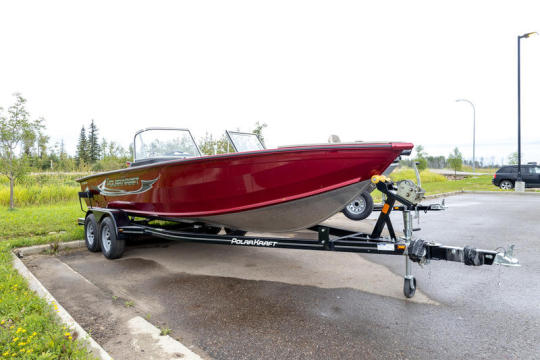
0 notes